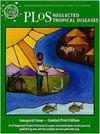开发用于检测和区分卵形疟原虫种类的新型实时 PCR 检测方法
IF 3.4
2区 医学
Q1 Medicine
引用次数: 0
摘要
背景 以前被称为卵形疟原虫的寄生虫种类、卵形疟原虫(P. ovalecurtisi)和卵形疟原虫(P. ovalewallikeri)在多个非洲国家流行。这两种疟原虫被认为在临床症状和潜伏期上有所不同,但现有的诊断方法中只有少数几种可以检测和区分它们。在这项研究中,我们试图利用最近公布的 P. ovalecurtisi 和 P. ovalewallikeri 的全基因组序列,开发用于检测和区分这两个物种的新检测方法。方法 在现有的 P. ovalecurtisi 和 P. ovalewallikeri 基因组中确定重复序列基团,并将其用于检测方法的开发和验证。我们使用合成质粒评估了性能最佳的单重和双重检测方法的分析灵敏度。然后,我们使用来自坦桑尼亚和刚果民主共和国(DRC)的一组样本评估了双联测定的特异性,并使用来自刚果民主共和国的 55 个卵形疟原虫样本和 40 个非卵形疟原虫样本验证了其性能。结果 性能最好的卵形疟原虫和卵形疟原虫靶标在参考基因组内分别有 9 和 8 个拷贝。P. ovalecurtisi检测灵敏度高,95%置信度检测下限(LOD)为3.6个寄生虫基因组当量/μl,而 P. ovalewallikeri检测的95%置信度检测下限为25.9个寄生虫基因组当量/μl。针对这两种寄生虫的双联测定特异性为 100%,95% 置信度 LOD 分别为 4.2 和 41.2 个寄生虫基因组当量/μl。结论 我们发现了有希望的多拷贝目标,可用于奥瓦莱克蒂斯寄生虫和奥瓦瓦莱克寄生虫的分子检测和鉴别,并利用它们开发了实时 PCR 检测方法。性能最好的 P. ovalecurtisi 检测方法在单复式和双复式格式中均表现良好,而 P. ovalewallikeri 检测方法在两种格式中均不能可靠地检测出低密度感染。这些检测方法可用于高通量鉴定卵黄囊虫,或鉴定适合下游下一代测序的高密度卵黄囊虫或卵黄囊虫感染。本文章由计算机程序翻译,如有差异,请以英文原文为准。
Development of new real-time PCR assays for detection and species differentiation of Plasmodium ovale
Background The parasite species formerly known as Plasmodium ovale , Plasmodium ovalecurtisi (P . ovalecurtisi ) and Plasmodium ovalewallikeri (P . ovalewallikeri ), are endemic across multiple African countries. These species are thought to differ in clinical symptomatology and latency, but only a small number of existing diagnostic assays can detect and distinguish them. In this study, we sought to develop new assays for the detection and differentiation of P . ovalecurtisi and P . ovalewallikeri by leveraging recently published whole-genome sequences for both species. Methods Repetitive sequence motifs were identified in available P . ovalecurtisi and P . ovalewallikeri genomes and used for assay development and validation. We evaluated the analytical sensitivity of the best-performing singleplex and duplex assays using synthetic plasmids. We then evaluated the specificity of the duplex assay using a panel of samples from Tanzania and the Democratic Republic of the Congo (DRC), and validated its performance using 55 P . ovale samples and 40 non-ovale Plasmodium samples from the DRC. Results The best-performing P . ovalecurtisi and P . ovalewallikeri targets had 9 and 8 copies within the reference genomes, respectively. The P . ovalecurtisi assay had high sensitivity with a 95% confidence lower limit of detection (LOD) of 3.6 parasite genome equivalents/μl, while the P . ovalewallikeri assay had a 95% confidence LOD of 25.9 parasite genome equivalents/μl. A duplex assay targeting both species had 100% specificity and 95% confidence LOD of 4.2 and 41.2 parasite genome equivalents/μl for P . ovalecurtisi and P . ovalewallikeri , respectively. Conclusions We identified promising multi-copy targets for molecular detection and differentiation of P . ovalecurtisi and P . ovalewallikeri and used them to develop real-time PCR assays. The best performing P . ovalecurtisi assay performed well in singleplex and duplex formats, while the P . ovalewallikeri assay did not reliably detect low-density infections in either format. These assays have potential use for high-throughput identification of P . ovalecurtisi , or for identification of higher density P . ovalecurtisi or P . ovalewallikeri infections that are amenable to downstream next-generation sequencing.
求助全文
通过发布文献求助,成功后即可免费获取论文全文。
去求助
来源期刊

PLoS Neglected Tropical Diseases
Medicine-Infectious Diseases
CiteScore
7.40
自引率
10.50%
发文量
723
审稿时长
2-3 weeks
期刊介绍:
PLOS Neglected Tropical Diseases publishes research devoted to the pathology, epidemiology, prevention, treatment and control of the neglected tropical diseases (NTDs), as well as relevant public policy.
The NTDs are defined as a group of poverty-promoting chronic infectious diseases, which primarily occur in rural areas and poor urban areas of low-income and middle-income countries. Their impact on child health and development, pregnancy, and worker productivity, as well as their stigmatizing features limit economic stability.
All aspects of these diseases are considered, including:
Pathogenesis
Clinical features
Pharmacology and treatment
Diagnosis
Epidemiology
Vector biology
Vaccinology and prevention
Demographic, ecological and social determinants
Public health and policy aspects (including cost-effectiveness analyses).
 求助内容:
求助内容: 应助结果提醒方式:
应助结果提醒方式:


